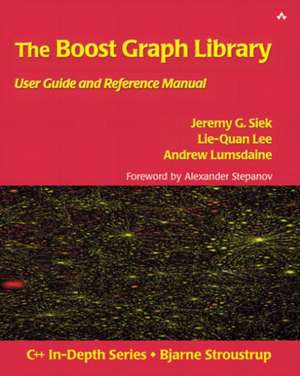The Boost Graph Library: User Guide and Reference Manual
Autor Jeremy G. Siek, Lie-Quan Lee, Andrew Lumsdaineen Limba Engleză Mixed media product – 19 dec 2001
Preț: 254.09 lei
Preț vechi: 317.61 lei
-20% Nou
48.62€ • 51.99$ • 40.54£
Carte indisponibilă temporar
Specificații
ISBN-10: 0201729148
Pagini: 352
Dimensiuni: 194 x 231 x 20 mm
Greutate: 0.61 kg
Ediția:1
Editura: Pearson Education
Colecția Addison Wesley
Locul publicării:Boston, United States
Descriere
Cuprins
Foreword.
Preface.
I User Guide.
1. Introduction.
Some Graph Terminology.Graph Concepts.Vertex and Edge Descriptors.Property Maps.Graph Traversa.Graph Construction and ModificationAlgorithm Visitors.Graph Classes and Adaptors.Graph Classes.Graph Adaptors.Generic Graph Algorithms.The Topological Sort Generic Algorithm.The Depth-First Search Generic Algorithm.
2.Generic Programming in C++.
Introduction.Polymorphism in Object-Oriented Programming.Polymorphism in Generic Programming.Comparison of GP and OOP.Generic Programming and the STL.Concepts and Models.Sets of Requirements.Example: InputIterator.Associated Types and Traits Classes.Associated Types Needed in Function Template.Typedefs Nested in Classes.Definition of a Traits Class.Partial Specialization.Tag Dispatching.Concept Checking.Concept-Checking Classes.Concept Archetypes.The Boost Namespace.Classes.Koenig Lookup.Named Function Parameters.
3. A BGL Tutorial.
File Dependencies.Graph Setup.Compilation Order.Topological Sort via DFS.Marking Vertices Using External Properties.Accessing Adjacent Vertices.Traversing All the Vertices.Cyclic Dependencies.Toward a Generic DFS: Visitors.Graph Setup: Internal Properties.Compilation Time.A Generic Topological Sort and DFS.Parallel Compilation Time.Summary.
4. Basic Graph Algorithms.
Breadth-First Search.Definitions.Six Degrees of Kevin Bacon.Depth-First Search.Definitions.Finding Loops in Program-Control-Flow Graphs.
5. Shortest-Paths Problems.
Definitions.Internet Routing.Bellman-Ford and Distance Vector Routing.Dijkstra and Link-State Routing.
6. Minimum-Spanning-Tree Problem.
Definitions.Telephone Network Planning.Kruskal's Algorithm.Prim's Algorithm.
7. Connected Components.
Definitions.Connected Components and Internet Connectivity.Strongly Connected Components and Web Page Links.
8. Maximum Flow.
Definitions.Edge Connectivity.
9. Implicit Graphs: A Knight's Tour.
Knight's Jumps as a Graph.Backtracking Graph Search.Warnsdorff's Heuristic.
10. Interfacing with Other Graph Libraries.
Using BGL Topological Sort with a LEDA Graph.Using BGL Topological Sort with a SGB Graph.Implementing Graph Adaptors.
11. Performance Guidelines.
Graph Class Comparisons.The Results and Discussion.Conclusion.II Reference Manual.
12. BGL Concepts.
Graph Traversal Concepts.Undirected Graphs.Graph.IncidenceGraph.BidirectionalGraph.AdjacencyGraph.VertexListGraph.EdgeListGraph.AdjacencyMatrix.Graph Modification Concepts.VertexMutableGraph.EdgeMutableGraph.MutableIncidenceGraph.MutableBidirectionalGraph.MutableEdgeListGraph.PropertyGraph.VertexMutablePropertyGraph.EdgeMutablePropertyGraph.Visitor Concepts.BFSVisitor.DFSVisitor.DijkstraVisitor.BellmanFordVisitor.
13. BGL Algorithms.
Overview.Basic Algorithms.breadth_first_search. breadth_first_visit. depth_first_search. depth_first_visit. topological_sort. Shortest-Path Algorithms.dijkstra_shortest_paths. bellman_ford_shortest_paths. johnson_all_pairs_shortest_paths. Minimum-Spanning-Tree Algorithms.kruskal_minimum_spanning_tree. prim_minimum_spanning_tree. Static Connected Components.connected_components. strong_components. Incremental Connected Components.initialize_incremental_components. incremental_components. same_component. component_index. Maximum-Flow Algorithms.edmunds_karp_max_flow. push_relabel_max_flow.
14. BGL Classes.
Graph Classes.adjacency_list. adjacency_matrix. Auxiliary Classes.graph_traits. adjacency_list_traits. adjacency_matrix_traits. property_map. property. Graph Adaptors.edge_list. reverse_graph. filtered_graph. SGB GraphPointer.LEDA GRAPH<V,E>. std::vector<EdgeList>.
15. Property Map Library.
Property Map Concepts.ReadablePropertyMap.WritablePropertyMap.ReadWritePropertyMap.LvaluePropertyMap.Property Map Classes.property_traits. iterator_property_map. Property Tags.Creating Your Own Property Maps.Property Maps for Stanford GraphBase.A Property Map Implemented with std::map.
16 Auxiliary Concepts, Classes, and Functions.
Buffer.ColorValue.MultiPassInputIterator.Monoid.mutable queue. Disjoint Sets.disjoint_sets. find_with_path_halving. find_with_full_path_compression. tie.graph_property_iter_range.
Bibliography.
Index. 0201729148T12172001
Notă biografică
Lie-Quan (Rich) Lee developed the first version of the BGL. A doctoral candidate at the University of Notre Dame, his research interests include generic programming, scientific component libraries, and high performance computing. Rich is an active member of the Boost C++ Library Group.
Andrew Lumsdaine is an Associate Professor in the Computer Science Department and Associate Director of the Open Systems Laboratory at Indiana University. In addition to generic programming and software engineering, his research program includes projects in computational science and engineering, parallel and distributed computing, mathematical software, and numerical analysis. Andrew is a member of the ISO C++ Standards Committee and the Boost C++ Library Group.
0201729148AB11212001
Textul de pe ultima copertă
"This book is unique because it discusses graph algorithms in terms of generic programming, and because it presents a concrete, usable library that embodies those algorithms."--Matthew H. Austern, AT & T Labs-Research
The Boost Graph Library (BGL) is the first C++ library to apply the principles of generic programming to the construction of the advanced data structures and algorithms used in graph computations. Problems in such diverse areas as Internet packet routing, molecular biology, scientific computing, and telephone network design can be solved by using graph theory. This book presents an in-depth description of the BGL and provides working examples designed to illustrate the application of BGL to these real-world problems.
Written by the BGL developers, The Boost Graph Library: User Guide and Reference Manual gives you all the information you need to take advantage of this powerful new library. Part I is a complete user guide that begins by introducing graph concepts, terminology, and generic graph algorithms. This guide also takes the reader on a tour through the major features of the BGL; all motivated with example problems. Part II is a comprehensive reference manual that provides complete documentation of all BGL concepts, algorithms, and classes.
Readers will find coverage of:
Groundbreaking in its scope, this book offers the key to unlocking the power of the BGL for the C++ programmer looking to extend the reach of generic programming beyond the Standard Template Library.
0201729148B11212001